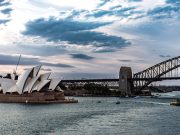Bridges have been a symbol of human progress and innovation for centuries. They connect people, places, and cultures, and have become iconic landmarks in their own right. From the ancient Roman aqueducts to the modern-day suspension bridges, engineers have pushed the boundaries of what is possible, creating structures that defy gravity and stand the test of time. In this article, we will take a tour of some of the world’s most famous bridges and engineering wonders, exploring their history, design, and impact on society. Join us as we cross boundaries and marvel at the ingenuity of human engineering.
1. “Bridging the Gap: Exploring the World’s Most Iconic Structures”
From the Great Wall of China to the Golden Gate Bridge, the world is filled with iconic structures that have stood the test of time. These structures not only serve as marvels of engineering, but also as symbols of human ingenuity and perseverance. In this section, we will explore some of the most famous structures from around the world and learn about their history, design, and cultural significance.
- The Great Wall of China: This ancient structure is one of the most recognizable landmarks in the world. Built over 2,000 years ago, the Great Wall stretches over 13,000 miles and was originally constructed to protect China from invading armies. Today, it is a popular tourist destination and a symbol of Chinese culture and history.
- The Eiffel Tower: This iconic structure is one of the most visited landmarks in the world, attracting millions of tourists each year. Built in 1889, the Eiffel Tower was originally intended to be a temporary structure for the World’s Fair. However, it proved to be so popular that it was allowed to remain standing. Today, it is a symbol of Paris and a testament to the power of human creativity and innovation.
Whether it’s the towering skyscrapers of New York City or the ancient pyramids of Egypt, the world’s most iconic structures have captured our imaginations for centuries. By exploring these structures and learning about their history and design, we can gain a deeper appreciation for the ingenuity and creativity of the human spirit.
2. “Engineering Marvels: A Journey Across Boundaries”
Engineering marvels are the epitome of human ingenuity and creativity. They are the result of countless hours of planning, designing, and testing, and they push the boundaries of what we thought was possible. From towering skyscrapers to intricate bridges, engineering marvels are a testament to our ability to overcome challenges and create something truly extraordinary.
- One of the most iconic engineering marvels is the Eiffel Tower in Paris, France. Built in 1889, it was the tallest man-made structure in the world at the time, standing at 324 meters. The tower was designed by Gustave Eiffel, a French engineer, and has become a symbol of France and one of the most visited tourist attractions in the world.
- The Burj Khalifa in Dubai, United Arab Emirates, is another engineering marvel that has captured the world’s attention. Completed in 2010, it is currently the tallest building in the world, standing at a staggering 828 meters. The tower was designed by Adrian Smith, an American architect, and required innovative engineering solutions to withstand the extreme temperatures and winds of the desert environment.
Engineering marvels are not limited to buildings and structures, however. They also include transportation systems, such as the Channel Tunnel that connects England and France, and the Panama Canal that connects the Atlantic and Pacific Oceans. These projects required extensive planning and engineering expertise to overcome the challenges of geography and natural obstacles.
3. “Crossing the Divide: A Tour of Bridges That Have Stood the Test of Time
Bridges are not just structures that connect two points, but they are also a symbol of human ingenuity and engineering excellence. They have been a part of human civilization for centuries, and some of them have stood the test of time. Here are some of the most iconic bridges that have crossed the divide and connected people across the world.
– The Golden Gate Bridge: This iconic suspension bridge in San Francisco, California, is one of the most recognizable structures in the world. It spans the Golden Gate Strait and connects San Francisco to Marin County. The bridge was completed in 1937 and was the longest suspension bridge in the world at the time. It is now a popular tourist attraction and a symbol of American engineering excellence.
– The Tower Bridge: This iconic bridge in London, England, is a combination of a suspension and a bascule bridge. It spans the River Thames and connects the north and south of London. The bridge was completed in 1894 and is now a symbol of London’s rich history and culture. The bridge is also famous for its two towers that are connected by walkways, which offer stunning views of the city. As we conclude our tour of iconic bridges and engineering wonders, we are left with a sense of awe and admiration for the incredible feats of human ingenuity that have made these structures possible. From the Golden Gate Bridge to the Millau Viaduct, these bridges have not only connected people and places, but have also pushed the boundaries of what is possible in engineering and design. As we continue to explore and innovate, we can only imagine what new wonders will be created in the future. Until then, we can look back on these iconic bridges with wonder and appreciation for the human spirit of exploration and creativity.





























